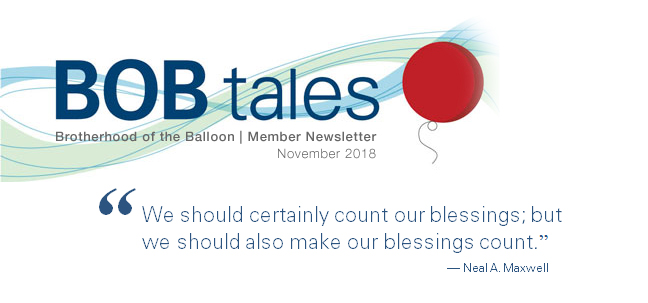
A Note from Deb Hickey:
Dear Members:
This month, I thought I’d take a little walk down memory lane. I searched my computer for the earliest November issue of BOB Tales I could find, and it took me back to 2010, the year I decided to leave my career in Internet marketing and start working with my father and his “ministry” full time.
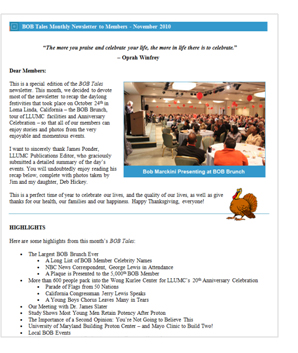 Part of my job was to format the monthly newsletter—lay out the text; add graphics, etc. If you look closely at the thumbnail on the left, you’ll not only see a clip-art picture of a turkey (tacky), you also may notice the memo is only three paragraphs long. Wow.
Part of my job was to format the monthly newsletter—lay out the text; add graphics, etc. If you look closely at the thumbnail on the left, you’ll not only see a clip-art picture of a turkey (tacky), you also may notice the memo is only three paragraphs long. Wow.
I went through the rest of the newsletter to see how things have changed in the past eight years. The first thing I noticed is that we’d just registered our 5,000th member. In the past eight years, that number has more than doubled. Our group is certainly doing a respectable job of spreading the word about proton therapy for prostate cancer!
Later in the newsletter, we wrote about LLUCC’s 20th anniversary proton center celebration (this was my first trip to Loma Linda). During that event, Bob Marckini reported that our group was responsible for contributing $6 million to proton therapy research, and later he presented a check from the Brotherhood to Dr. Jerry Slater in the amount of $500,000.
Later in this issue, you’ll see an update on the funds raised by our membership, along with a detailed list of where that money goes.
In our November 2010 issue, we announced the Mayo Clinic was planning to build two proton centers in Rochester, MN and in Phoenix, AZ. I remember Bob and I being thrilled with this news—we felt a premier cancer center like Mayo Clinic embracing proton therapy would help silence those who claimed it was “experimental.” To add to the excitement, the University of Maryland also announced they’d be building a proton center. We didn’t realize at the time we’d still be fighting to prove the efficacy of proton therapy eight years—and 22 proton centers—later.
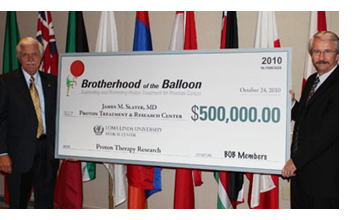 During our visit to LLUCC in 2010, my father and I were interviewed for the Loma Linda Broadcasting Network’s Journey of Hope program. I haven’t seen that video in years, though I remember being extremely nervous on camera. I tried to find it online so I could share it with our readership, but unfortunately, I couldn’t. The good news is—I found this video, also from 2010. Titled, Proton Therapy: Giving Back, my father and I recorded it in my living room in celebration of LLUCC’s 20th anniversary.
During our visit to LLUCC in 2010, my father and I were interviewed for the Loma Linda Broadcasting Network’s Journey of Hope program. I haven’t seen that video in years, though I remember being extremely nervous on camera. I tried to find it online so I could share it with our readership, but unfortunately, I couldn’t. The good news is—I found this video, also from 2010. Titled, Proton Therapy: Giving Back, my father and I recorded it in my living room in celebration of LLUCC’s 20th anniversary.
In the six-minute video, Bob talks candidly about his prostate cancer diagnosis and then introduces me. And there I am, eight years younger, discussing my childhood and the fact that a cancer diagnosis never affects just one person—it’s a family disease. I found myself tearing up through much of it.
Bob goes on to talk about LLUCC’s pioneering work with proton therapy and our appreciation for the tens of thousands of patients who have been treated—the lives that have been saved; the families that have been kept whole; and the quality of lives that have been preserved. He then implores our membership to help in our goal to present LLUCC with a $500,000 check at the anniversary celebration happening in a few weeks. And as you know, we reached our goal!
So, some things never change: Our members are still giving and we’re still asking. We’ve included our “Giving Back” section in every newsletter, followed by information on how to make a contribution to proton research at LLUCC. We don’t do this because we are asked. We don’t do this because we’re here to simply promote philanthropy. We do this because we are overwhelmed with gratitude—especially as the years pass and my father is still here to sing happy birthday over the phone to me with his digital piano—and because we truly believe in proton therapy, not only for prostate cancer, but for other diseases as well. Personally, I follow research on proton therapy for pediatric cancers. And, researchers are making advancements all the time which wouldn’t be possible without continued donations.
So, although much has changed over the years, some things haven’t: Funding is still needed to further proton therapy research, helping patients suffering from not only prostate cancer, but many other conditions. And, any amount helps. Please read our Giving Back section and consider making a contribution—the Thanksgiving season is a great time to start.
We have another update on the COMPPARE trial. The first site is accepting patients—the University of Florida Health Proton Therapy Institute—and they already have 43 signed on. Also, the team has launched a new website—COMPPARE.org. As we learn more about this critically important study comparing proton therapy to intensity-modulated radiation therapy (IMRT) for prostate cancer, we will let you know. In the meantime, we recommend you visit the website to learn more about this critically important study.
In this month’s issue, you’ll read about a retired plastic surgeon’s biopsy nightmare. And, we’ll tell you the three most important things you should know before having a biopsy that you may want to share with family and friends. We also cover some other important topics including: how to fight prostate cancer with food; the potential for misdiagnosis when relying solely on the prostate-specific membrane antigen (PSMA) PET; and a new study on early-life alcohol consumption and increased risk of prostate cancer.
As always, we love to hear from our readers—please send us your feedback.
Deb Hickey
To print the BOB Tales newsletter or view the newsletter with a larger font size, click here for the PDF file.
In this Issue:
- Beware of Prostate Biopsies
- Fighting Prostate Cancer with Food
- “Major Pitfall” in Prostate Cancer PET Imaging Method
- History of Moderate/Heavy Drinking Linked to More Aggressive Prostate Cancer
- More Positives on Green Tea
- 4 Foods—Other than Green Tea—Able to Help Fight Cancer

Beware of Prostate Biopsies
MedPage Today recently published an article on this subject, telling the story of a retired plastic surgeon’s nightmare. Dr. Fred Becker, Jr. was especially cautious because his father and older brother died from prostate cancer and another brother, who died from cardiovascular disease, also had prostate cancer.
Dr. Becker was initially diagnosed with low-risk, low-volume, Gleason 6 cancer. But a mistake was made later on follow-up testing. His MRI records were accidentally switched and he was told he had aggressive cancer that needed aggressive treatment.
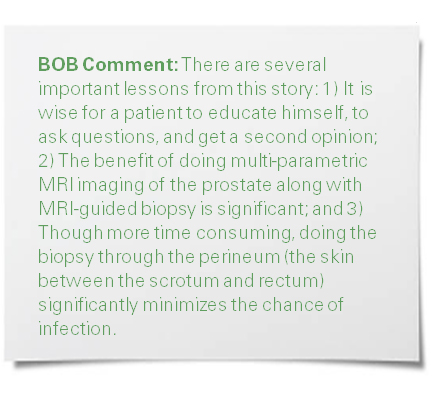
Shortly after his biopsy, Dr. Becker’s fever spiked and he became delirious. He was diagnosed with sepsis. According to the article’s author, the risk of infection from transrectal biopsy varies from doctor to doctor, but is about 5 percent. Dr. Becker believes prostate biopsy infections are under-reported and the rates are actually higher. The Sepsis Alliance, a health organization, reports about 30 percent of patients diagnosed with sepsis die from the condition.
After successfully recovering from the sepsis, Dr. Becker had to deal with the belief that he had aggressive prostate cancer. Further investigation, including more testing and getting second and third opinions, revealed that his MRI records had been switched. Dr. Becker actually had low-grade, Gleason 6 prostate cancer that could be dealt with using active surveillance.
Fighting Prostate Cancer with Food
Researchers implanted human cancerous tumors in mice and then experimented with the animals’ diets. Results were reported in Health24.
Corn Oil vs. Fish Oil
High-fat diets seem to promote cancer growth. Corn oil, which contains omega-6 fat, for example, was found to promote prostate cancer tumor growth when increased, and slow the growth when decreased. On the other hand, by increasing the omega-3 level in the diet from fish oil, the tumors shrank in size.
Researchers next took these findings to human studies. Men diagnosed with prostate cancer and scheduled for radical prostatectomies were randomly assigned to one of two groups. Four to six weeks before surgery one group was fed a typical western diet. The other was fed a low fat diet with fish oil. After the prostates were removed, researchers examined the tissue for Ki-67 protein. Measuring this protein is done with cancer patients to determine how rapidly the cells are dividing. The men on the low-fat fish oil group had noticeably lower Ki-67 levels, i.e. slower rates of cancer cell division.
One conclusion reached in this study is that men with early stage prostate cancer who have chosen active surveillance would be wise to avoid a high-fat diet, especially one with corn oil, and to eat a lower-fat diet including omega-3 fats from fish oil. The jury is still out, however, on whether fish oil supplements provide the same benefit as consuming fish.
Researchers in these same studies also reported that tumor growth can be slowed through exercise and weight loss
These findings could provide benefits to men who are practicing active surveillance as well as men who have been treated for prostate cancer and want to take steps to prevent a recurrence.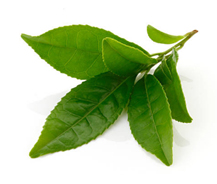
Green Tea
Researchers in the same study also reported that green tea with polyphenol anti-oxidant components can be beneficial to men with prostate cancer. A new trial is being started to study this more closely. Men are being enrolled in this study. One question being examined is whether green tea might help prevent prostate cancer.

“Major Pitfall” in Prostate Cancer PET Imaging Method
Researchers are cautioning medical professionals to be aware of the potential for misdiagnosis when relying solely on the prostate-specific membrane antigen (PSMA) PET. The study is featured in the Journal of Nuclear Medicine’s September issue.
PSMA is a highly expressive enzyme in prostate cancer cells and metastases, which makes it a useful target for imaging, allowing physicians to more easily diagnose the cancer and determine best treatments. However, some studies have noted that some benign tissues also show increased PSMA expression and could be confused with lymph node metastases. The result could be a misdiagnosis and unnecessary change in therapy regimen.
Despite these findings, researchers advise medical professionals not to abandon PSMA PET imaging. “We hope that an increased awareness among nuclear medicine physicians of this important pitfall helps to increase diagnostic accuracy and improve therapy guidance, preventing unnecessary procedures for prostate cancer patients,” said Christoph Rischpler, MD, in the department of nuclear medicine at the Technical University of Munich in Germany.
History of Moderate/Heavy Drinking Linked to More Aggressive Prostate Cancer
 Among men getting a prostate biopsy, those with a history of consuming seven or more drinks a week—no matter whether the drinking occurred in youth or later in life—are more likely than non-drinkers to be diagnosed with an aggressive tumor, a recent study suggests.
Among men getting a prostate biopsy, those with a history of consuming seven or more drinks a week—no matter whether the drinking occurred in youth or later in life—are more likely than non-drinkers to be diagnosed with an aggressive tumor, a recent study suggests.
Researchers also looked at lifetime alcohol exposure and found a more than three-fold increased risk of a high-grade tumor in men who consumed more than 10,660 drinks—about one drink a day for 30 years.
Survey data was collected from a group of racially diverse men, ages 49-89 years, undergoing prostate biopsy at the Durham Veterans Affairs Medical Center between 2007 and 2018. Men completed a survey to assess the average number of alcoholic beverages consumed weekly during each decade of life.
Experts agreed that this one study isn’t enough to suggest new recommendations regarding alcohol consumption.

We’ve been producing BOB Tales newsletters monthly for nearly 18 years. During this time there have been important articles that many new members haven’t seen, and some long-time members may have forgotten. So, we decided to periodically re-run articles from past newsletters. The following is from January 2005.
More Positives on Green Tea
New research to be published in the journal Cancer Research has found the polyphenols in green tea help prevent the spread of prostate cancer. They do so by targeting molecular pathways that shut down the proliferation and spread of tumor cells, as well as inhibiting the growth of tumor-nurturing blood vessels. Researchers from the University of Wisconsin documented the role of green tea polyphenols (GTP) in modulating the insulin-like growth factor-1 (IGF-1)-driven molecular pathway in prostate tumor cells in a mouse model for human prostate cancer. They noted that drinking up to 12 cups of green tea per day has no known toxic effects on the human body.

This Never Gets Old
We love hearing from our members. The feedback we receive never gets old—especially when we read messages like these:
Thanks so much for sharing the positive news about Mark and Kate and their journeys with pancreatic cancer. In this time of so much negativity in the political and international news, it’s heartening to hear good news … Your experience enhances the great respect and appreciation I have for you and the work you do. —Arlind Hackett, Highland, CA
My wife and I have had the opportunity to travel throughout China as well as visiting Hong Kong and Macau, Thailand, Cambodia, and Vietnam. These opportunities would not have been ours if it hadn’t been for my successful proton treatment at LLUCC. Life is good and very fulfilling. I’m eternally grateful for proton therapy for giving me back my life. —BOB Member, Salt Lake City, UT
The BOB newsletter is such a gift—I get excited when I see it in my inbox. Thank you for your continued efforts—they don’t go unappreciated! —BOB Member, Tulsa, OK
I just wanted to share some great news. I finished my proton treatment at California Protons in June. I had my first PSA test last week and it was better than I expected! I’m so grateful for Bob’s book and all the encouragement and information from the BOB. What a blessing! Thank you so much! You’re doing great work! —BOB Member, Lincoln, CA
Seventeen years later (80 years old), I’m cancer free. This week’s PSA was low, and I don’t wear diapers. I’ve probably referred a dozen guys to Loma Linda for proton treatment. —BOB Member, Camarillo, CA
I was treated at UFHPTI in Jacksonville in 2013 and I feel fantastic at the five-year mark! Thank you for continuing to educate us BOB members on advancements in proton therapy and other pertinent health-related news—I forward your newsletter every month to my family and friends. —BOB Member, Melbourne, FL
Support for Veterans—Members Come Together
Last month, we asked our members to help the National Association for Proton Therapy (NAPT) in their efforts to expand proton therapy coverage for U.S. veterans by sending letters to their state representatives and senators, requesting they urge the head of the Veterans Health Administration to examine the evidence supporting proton therapy and ensure a path for all veterans to have proton as a choice when fighting certain cancers.
The response was heartening; we received many emails asking for the letter template with messages of support and promise to follow through. Below are a few excerpts. Thank you to everyone who lent their support on this important initiative.
I read the Proton BOB newsletter eagerly every month. I saw your request for help for our service men to have access to proton therapy. I want to help! Please send me the templatized letter and I’ll do what I have to do.
—BOB Member, Houston, TX
I am a veteran and a BOB member. I’m honored to help in this initiative. Thank you and the National Association for Proton Therapy. —BOB Member, Peoria, AZ
I was interested to see that there is some move to help vets and will be looking forward to further information that I can share with the vets that call me. As you know, I’m on the former proton patient call list for Loma Linda. To date, I’ve sent more than 10 men to Loma Linda and I’ve never heard a bad report.
On a personal note, I graduated Loma Linda in 2006. I just had my annual check-up at the VA and my PSA has stayed low for 12 years. Who can argue with results like that? Keep up the great work you are doing and God bless. —BOB Member, Salmon, ID
As we said last month, we know we have members who are willing to go above and beyond to “support the cause” and we really appreciate it.
If you’d like to help veterans have access to proton therapy, please consider sending letters to your state representatives. To receive a letter template and mailing information for your state, please send an email to Deb Hickey.

Year-End Giving
As December is approaching, you may be planning your year-end giving. We hope you’ll consider making a gift to either the Robert J. Marckini Endowed Chair for Proton Therapy Research or to Vision 2020 at Loma Linda University Health.
Marckini Chair
The Robert J. Marckini Endowed Chair was established in 2013 through a very generous gift from BOB member Chuck Kubicki. Since then, members have regularly contributed to the chair, often in honor of Bob Marckini or Deb Hickey, caregivers at LLUCC, or family members. Each month, we are given a list of contributors, and it’s our pleasure and honor to reach out and personally thank those making gifts.
The Chair is funded at $3.175 million and supports important research at LLUCC. Some of the research the Marckini Chair supports includes:
- New treatment sites—240 parts of the body are routinely treated with protons
- Treating new histologic subtypes of cancer—over 200
- Breast cancer treatment research—working on treating advanced breast cancer
- Arteriovenous malformation (AVM) of the brain—especially in pediatric patients
- Hypo-fractionation treatment of prostate cancer—extraordinary results with clinical trials
- Active beam scanning for more precise targeting of certain tumors
- Treating atrial fibrillation of the heart with protons
- Treating neurological pain from war veteran amputees
- Other clinical trials including esophageal cancer, advanced liver cancer, pancreatic cancer, and soft tissue sarcoma
Vision 2020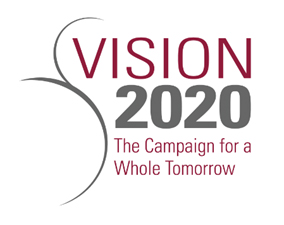
Vision 2020 is a $1.4 billion campaign at Loma Linda University Health to build a new adult hospital, expand the Children’s Hospital, and fund a broad range of research initiatives, which includes proton therapy and prostate cancer.
About $360 million of the $1.4 billion needs to be raised through philanthropy and they are about $57 million from that goal.
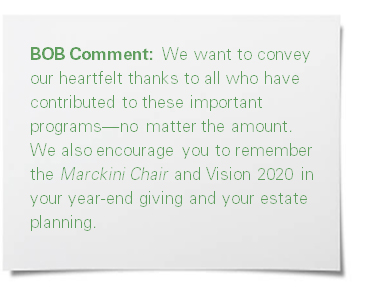 About 40 percent of our members have contributed to these efforts, including members who were treated at proton centers other than LLUCC. They do this because they know their treatment may not have been possible if it hadn’t been for the pioneering work done by the folks at LLUCC. BOB members have contributed more than $12 million to various LLUH programs ($1 million came from Chuck Kubicki who directed his gift to the Proton Priority Fund of Vision 2020).
About 40 percent of our members have contributed to these efforts, including members who were treated at proton centers other than LLUCC. They do this because they know their treatment may not have been possible if it hadn’t been for the pioneering work done by the folks at LLUCC. BOB members have contributed more than $12 million to various LLUH programs ($1 million came from Chuck Kubicki who directed his gift to the Proton Priority Fund of Vision 2020).
How to Give
How to Give to Proton Therapy Research
- Donate Online: Visit the LLUCC website.
- Send a Check: Make it out to “LLUCC Proton” with “Marckini Chair” on the memo line and send to: LLUH, Office of Philanthropy, P.O. Box 2000, Loma Linda, CA 92354.
- Make a Call: Contact Regina Joseph at 909-558-5010.
How to Give to Vision 2020
- Donate online: Visit the LLUH website.
- Send a check: Make it out to: “LLUH Vision 2020.” Mail to: LLUH, Office of Philanthropy, P.O. Box 2000, Loma Linda, CA 92354.
- Make a call: Call 909-651-2020.
How to Make a Future Gift
- Make a future gift: Contact Todd Mekelburg at the Office of Planned Giving at Loma Linda University Health at 909-558-5376 or [email protected].
- Other ways to give: Contact Matt Miller at the Office of Philanthropy at Loma Linda University Health at 909-558-3582 or [email protected].

NAPT Conference 2019
The National Association for Proton Therapy (NAPT) is the voice of the proton community. The organization provides education and awareness for the public, professional, and governmental communities. Join the National Association for Proton Therapy for the 2019 National Proton Conference March 24 - 27, 2019, at The Biltmore Miami Coral Gables in Coral Gables, FL. Attendees will include physicians, nurses, therapists, patients, proton therapy directors and managers. Learn more.


Bug Dodging 101
It’s that time of year. Head colds and flu viruses will soon be on the rise. Thankfully, there are things you can do to increase your chances of staying healthy according to Dr. Brett Hurteau, board certified physician, specializing in family medicine. In a recent article in Southcoast Health, he suggests the following:
Take care of your overall health.
Sounds pretty obvious: Eat a balanced diet. Get enough sleep. Exercise regularly. Drink lots of water. All these things help to strengthen your immune system.
Wash your hands often.
This can be a major source of cold and flu prevention. We touch things dozens of times a day that contain germs—money, doorknobs, grocery cart handles, etc. Carry hand sanitizer and wash your hands often.
Keep bathrooms and kitchens clean.
These are two of the major sources of germs in a household, so focus on keeping them clean by wiping down counters and other surfaces that may be contaminated with germs.
Learn how to sneeze and cough properly.
Ideally, use a tissue and throw it away. If tissues aren’t available, cough into the crook of your elbow. Never cough into your hands. The next time you touch something your germs will be transferred and others can pick them up.
Tip: Teach your children to cough or sneeze into the crook of their arm. Deb Hickey calls it the “chicken wing” technique which is a funny reminder for her 7-year-old.
Don’t share.
We teach our children to share their toys and other belongings, but that is a sure-fire way to spread germs during the cold and flu season. Children should never share things like cups, juice boxes, snacks, and other things that have been around their mouths.
Learn your children’s school/daycare policies.
Find out about their policies on sharing food and personal items. Make sure your children/grandchildren are enrolled somewhere that has good health policies and that they are enforced.
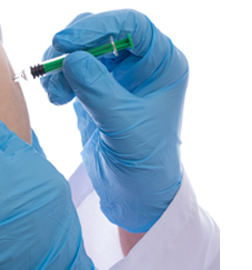 Get a flu shot.
Get a flu shot.
Flu season is typically October through April. Essentially everyone should benefit from a flu shot or nasal spray alternative.
Tip: If you don’t want to wait for a doctor’s appointment, most local pharmacies will administer the flu shot—just walk in; no appointment is necessary.
With a few preventive measures, your children and grandchildren will be less likely to catch a cold or flu bug and take it home to the family.
4 Foods—Other than Green Tea—Able to Help Fight Cancer
There are many food options that help prevent cancer. We’ve written about green tea many times in our newsletter: Green tea 1) slows down the growth of cancer cells; 2) blocks formation of new blood vessels that cancers need to feed themselves with nutrients; 3) may boost the immune system; and 4) appears to trigger natural detox enzymes in our body that help protect against cancer formation. Did you know there are four other foods that are also pretty tough on cancer?
Broccoli
This cruciferous vegetable contains properties that can prevent prostate cancer and bladder cancer. Broccoli is high in fiber and sulforaphane, a phytochemical in broccoli that boosts the body’s protective enzymes and helps eliminate chemicals that cause cancer.
Oranges
Oranges contain vitamin C, a good source of nutrients due to its antioxidant effects, which can prevent or delay cell damage. Also, the oil in citrus fruit peels contains a phytonutrient that stimulates our antioxidant detoxification enzyme system, which helps prevent cancer.
Ginger
Numerous studies have reported that ginger extract has anti-metastatic properties that inhibit many types of cancer, including prostate. The properties of ginger have also been found to activate cell apoptosis (cell suicide).
Garlic
Garlic contains sulfur compounds and stimulates the immune system’s natural defense against cancer. It also has the potential to reduce tumor growth.
Instead of Taking Multivitamins …
Eat a healthful diet. Dr. Keith Roach has been a practicing internist for over 20 years. He’s also a co-creator of the RealAge Test. Dr. Roach says that many studies consistently show that most of the vitamins in a multivitamin tablet (with the exception of vitamin D) don’t improve health or prevent illness. Instead of taking a multivitamin, he encourages a healthful diet with plenty of fresh fruits and vegetables.
Series: “Make Vegetables Taste Good”
This is the 24th segment on a subject that’s consistent with our Anticancer series. We made it our mission to find recipes that make vegetables and other healthful foods taste delicious. And, we’ve tried them all!
Sweet potatoes serve as the base to make the cheesy orange sauce in the following mac and cheese recipe. This is one of Deb Hickey’s daughter’s favorites and is much more healthful than many of the boxed mac-and-cheese options found in your local supermarket.
Vegan Sweet Potato Mac and Cheese with Spinach
Ingredients
- 2 medium sweet potatoes
- 1 pound dried pasta shells
- 1/3 cup vegan butter
- 1/3 cup flour
- 2 cups unsweetened non-dairy milk
- 3 garlic cloves, minced
- 2 teaspoons Dijon mustard
- 2 teaspoons white miso
- 1/2 teaspoon cayenne
- 1 teaspoon nutmeg
- 1/2 teaspoon salt
- 2 tablespoons nutritional yeast
- 2 cups baby spinach, chopped
- Freshly ground pepper, to taste
Directions
Preheat oven to 425°F. Poke a few holes into sweet potatoes and wrap them in foil. Bake until cooked through, about 60 minutes. When potatoes are cooked and slightly cool, scoop out the flesh and discard the skins. Set flesh aside.
Cook pasta according to package instructions. Drain and set aside.
In a medium pot, melt the butter. Stir in flour and cook, stirring frequently for 3-5 minutes until mixture thickens. Stir in half the non-dairy milk and continue stirring another 2 minutes as mixture continues to thicken. Stir in sweet potatoes. Add in remaining milk, garlic, mustard, miso, cayenne, nutmeg, nutritional yeast, and salt. Continue cooking another few minutes until a thick consistency is reached.
Transfer sauce to a blender and blend until smooth. Place cooked pasta into the sauce pot. Over low heat, pour blended sauce over pasta and stir well. Stir in baby spinach and cook about two minutes until pasta is warm and spinach is wilted.
Serve with freshly ground pepper.

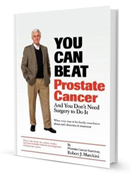
“Support from patients more helpful than doctors!”
This is the title from a recent Amazon book review. The reviewer may be referring to Bob Marckini and the fact that he wrote a book about his experience, but this is certainly not the first time we’ve heard new or prospective proton patients praise former proton patients for their unwavering support during the treatment decision-making process. It reminds us of the myriad ways our members “pay it forward” and help newly diagnosed men and their family members learn about proton therapy for prostate cancer. Every day, you are helping to build awareness and educate others about proton therapy. We are thankful—you’re making a difference!
Below are two recent reviews.

Support from patients more helpful than doctors!
This is a very helpful read for the newly diagnosed. Clear and simple—helps you get through all the confusing and complex information coming from doctors. We gave a copy to a neighbor who was recently diagnosed.

Excellent, Comprehensive Presentation of Proton Beam Therapy
After reading a couple of books on prostate cancer and leaning toward proton beam therapy for treatment, I read Mr. Marckini’s book. I found it to be one of the most readable (for the lay person), yet informative books with extremely sound reasoning offered. I HIGHLY recommend any individual with prostate cancer read this book before choosing a treatment option.
We need your help.
Many medical professionals aren’t informed about proton therapy and most mainstream media (and some doctors) discount proton therapy as a viable treatment option. We’re fighting daily for this to change. One way is through Bob’s book. Please help others find it by posting a review on Amazon and rating it from one to five stars.
Buy Online, in Bulk or in Spanish
Online: Paperback: $19.00--•--Kindle: $7.99--•--NOOK Book: $9.99--•--Apple iBook: $9.99
In Bulk: Conctact us for a discount price list. Proceeds from book sales support proton therapy research through the Robert J. Marckini Endowed Chair at LLUCC.
In Spanish: Buy the print version or in eBook format.
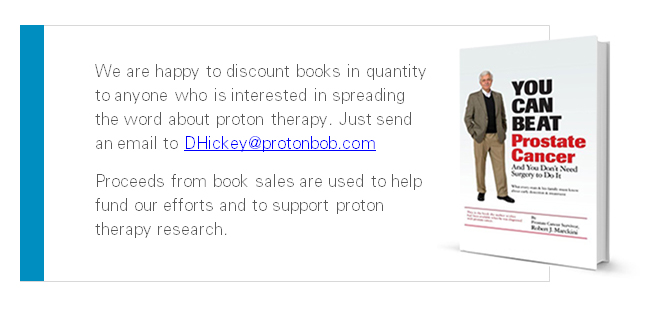

I didn’t know that!
- The smallest sovereign entity in the world is the Sovereign Military Order of Malta (SMOM). It is located in the city of Rome, Italy and is roughly the size of two tennis courts. As of 2001, SMOM has a population of 80—20 fewer people than the Vatican. It is a sovereign entity under international law, just like the Vatican.
- In the Sahara Desert, there is a town named Tidikelt, Algeria. Tidikelt didn’t receive a drop of rain for 10 years. Technically, though, the driest place on Earth is in the valleys of the Antarctic near Ross Island. Some scientists believe there has been no rainfall there for two million years.
- Spain literally means “the land of rabbits.”
- St. Paul, MN was originally called “Pig’s Eye” named after Pierre “Pig’s Eye” Parrant, who set up the first business there.
- Los Angeles’ full name is “El Pueblo de Nuestra Señora la Reina de los Angeles del Rio Porciúncula” and can be abbreviated to 3.63 percent of its original size: L.A.
- The deepest hole ever made in the world is in Texas. It’s as deep as 20 Empire State buildings but only 3 inches wide.
Estate Planning Hints
BOB Member Ron Hendricks is Director of Gift Planning for Trinity Western University. He regularly copies us on his “News from Ron” mailings, which are helpful hints on estate planning to the readers of his newsletters. We have found Ron’s suggestions to be timely and beneficial. With his permission we periodically share some of his wisdom with our membership. The following segment is called …
Wisdom Principle
Never pass wealth without first passing wisdom. Wealth will never create wisdom, although wisdom may help create wealth.
It was Billy Graham who said, “If a person gets his attitude toward money straight, it will help straighten out almost every other area in his life.”
During your lifetime, you should teach your children biblical principles regarding the use of money and stewardship. After your death, you can assist them in the following ways through their inheritance.
Income Rather Than Principal: Many parents have one or more children who may act in harmful ways with a substantial amount of money. One good solution is to provide income to everyone for a term of years or for his or her lifetime. A trust is an excellent method for this purpose. The trustee can also have discretion to distribute principal, or at an age you select the trust property can be given to your children.
Management: If you plan to pass an inheritance to children, a trust enables you to select the person or the institution that will be best qualified to manage those assets.
Tax Savings: If your estate is more than the allowed exemption, it may in future years be subject to taxes at a very high rate. For individuals who support charity, a great plan is to create a trust or make charitable gifts with the majority of the estate and replace the gifted property with an insurance trust.
Income: After your demise, the trustee will invest the proceeds and pay income to the beneficiaries. Some trusts last until the beneficiary has reached a specific age, or the trust may last for their lifetimes. The primary goal of many parents is to provide an additional level of economic security for the children. This income stream will provide payouts for the rest of their lifetimes. The trustee may be given permission to distribute principal. This could be based upon such standards as health, education, maintenance and support, or may be discretionary with the trustee.

Last Month’s Brain Teaser
What is unusual about the following words?
Revive, banana, grammar, voodoo, assess, potato, dresser, uneven
Answer: Take the first letter of each word and place it at the end. It will spell the same word backwards.
Winner: The winner of last month’s brain teaser is Joseph Shields of Loganville, GA. Joseph was treated for prostate cancer with proton therapy at UFHPTI in Jacksonville, FL in 2012. Lucky for him, his wife had learned about proton therapy from a childhood friend shortly after he was diagnosed.
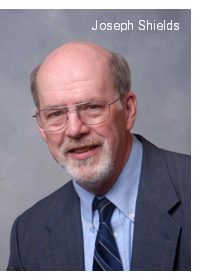 Joseph graduated college with a Bachelor of Theology in Christian Ministries in 1963 and in 1981, earned a Master of Divinity in Biblical Studies. He has served in volunteer prison ministries since 1988. In fact, Joseph was working as a Chaplain at Stewart Detention Center (an ICE detention facility) when he was diagnosed with prostate cancer.
Joseph graduated college with a Bachelor of Theology in Christian Ministries in 1963 and in 1981, earned a Master of Divinity in Biblical Studies. He has served in volunteer prison ministries since 1988. In fact, Joseph was working as a Chaplain at Stewart Detention Center (an ICE detention facility) when he was diagnosed with prostate cancer.
Joseph is now semi-retired, working part-time at a local cooperative ministry. He has four children, nine grandchildren, and five great-grandchildren.
Congratulations, Joseph! Your signed copy of Bob’s book is on the way.
New Brain Teaser
This is a tough one.
What makes this number unique?
8,549,176,320
Send your answer to [email protected] for a chance to win a signed copy of Bob Marckini’s book, You Can Beat Prostate Cancer.
Bad Puns
Which rock group has four guys who can’t sing or play instruments?
Mount Rushmore
I couldn’t figure out why the baseball kept getting bigger.
Then it hit me.
People think “icy” is the easiest word to spell.
Come to think of it, “I see why.”
A guy was admitted to hospital with eight plastic horses in his stomach.
His condition is now stable.
Which country’s capital is the fastest growing?
Ireland’s—every year it’s Dublin.
Lexophilia
A lexophile is a lover of words—especially in word games, puzzles, anagrams and palindromes, often with a humorous theme. Here are a couple examples of lexophilia: “You can tune a piano, but you can’t tuna fish;” or “To write with a broken pencil is pointless.”
A competition to see who can come up with the best lexophiles is held every year in an undisclosed location. Following are submissions for this year’s competition:
- A thief who stole a calendar got 12 months.
- The batteries were given out free of charge.
- When the smog lifts in Los Angeles U.C.L.A.
- A will is a dead giveaway.
- With her marriage, she got a new name and a dress.
- A boiled egg is hard to beat.
- When you’ve seen one shopping center you’ve seen a mall.
- Police were summoned to a daycare center where a 3-year-old was resisting a rest.
- Did you hear about the fellow whose entire left side was cut off? He’s all right now.
- When a clock is hungry it goes back four seconds.
- The guy who fell onto an upholstery machine is now fully recovered.
- When she saw her first strands of gray hair she thought she’d dye.
- Acupuncture is a jab well done. That’s the point of it.
Church Humor
The Preacher’s Announcement
One Sunday morning, a preacher announced to his congregation, “I have good news and bad news. The good news is we have enough money to pay for our new building program. The bad news is it’s still in your pockets.”
Church Rules
A Sunday school teacher asked the children just before she dismissed them to go to church, “Why is it necessary to be quiet in church?”
Annie replied, “Because people are sleeping.”
The Birthday Gift
For our pastor’s 50th birthday, the congregation decided to give him a new suit. He was so touched by the gift that the following Sunday he stood before everyone and, with tears in his eyes, announced, “Today I am preaching to you in my birthday suit.”
Quote of the Month:
“A wise man once said … nothing.” —Unknown

Thank You
This Thanksgiving, we give thanks to the people and organizations that help us with our mission. Without you, this “ministry” wouldn’t exist.
Thank you, our members, for your devotion to “the cause,” for sharing with others your knowledge and passion for proton therapy; for the constant feedback and messages of gratitude; for those who have volunteered to help others who haven’t yet found their way; and for your ongoing generosity through gifts for proton research and Vision 2020.
Thank you, Dr. James M. Slater, Dr. Jerry Slater, and Loma Linda University Cancer Center, for pioneering proton therapy for prostate cancer and other diseases 28 years ago so that tens of thousands could have their cancers cured and the quality of their lives preserved. Thank you also for your support of the Brotherhood of the Balloon, your encouragement, and your unwavering faith in our mission.
Thank you, LLUCC senior management for your support of our efforts in so many ways.
Thank you, all the proton centers, for acknowledging the significant benefits of proton therapy, for making the capital investment to build 28 proton centers in the U.S. and for enabling thousands more patients to benefit from this technology.
Thank you, Scott Warwick and the National Association for Proton Therapy, for building awareness and educating others about proton therapy; for your support of our organization; and for being a valuable resource.
Thank you, Dr. Nancy Mendenhall at the University of Florida Health Proton Therapy Institute, for aggressively leading the effort on the COMPPARE trial comparing proton therapy to IMRT for prostate cancer. Thank you also to the stakeholders, physicians, scientists, statisticians, advisers, and patients, for making this study possible.
Thank you, all the physicians and administrative people connected with proton therapy, for routinely making yourselves available to us when we need answers to technical questions, information for our newsletters, or support for patients in need.\
Thank you, Pat Greany, for contributing to our newsletter. You go above-and-beyond in your research; your analysis is compelling; and your articles are exceptional.
Thank you, Bob Hawley, for your timely, careful, and professional reviews of our monthly newsletter.
Thank you, Ron Hendricks, for allowing us to reprint your helpful hints on estate planning.
Thank you, Larry Becker and team, for the thorough and timely editorial reviews of our monthly newsletter.
Thank you, Janya Mekelburg, for supporting our daily activities in so many ways and for your responsiveness when obstacles surface.
With the help of these people, we are making a difference: Our members are well informed ambassadors for proton therapy; our group is responsible for introducing hundreds of men each year to proton therapy; and we have responded to assaults and misinformation on proton therapy as well as attempts to stop reimbursing for proton treatment. Through our members, we have raised more than $12 million, most of which was directed to proton therapy research. We are proud of our group and thankful for our members and all who support our efforts.
We would like to wish you all a very special Thanksgiving.
Low PSAs to all!
Bob Marckini and Deb Hickey
To print the BOB Tales newsletter or view the newsletter with a larger font size, click here for the PDF file.
Acknowledgement: Research reported in this newsletter was partially funded through a Patient-Centered Outcomes Research Institute (PCORI) Award (PCS-2017C1-0422). The views, statements, and opinions presented in this newsletter are solely the responsibility of the author(s) and do not necessarily represent the views of the Patient-Centered Outcomes Research Institute (PCORI), its Board of Governors or Methodology Committee.
NO MEDICAL ADVICE: Material appearing here represents opinions offered by non-medically-trained laypersons. Comments shown here should NEVER be interpreted as specific medical advice and must be used only as background information when consulting with a qualified medical professional.
